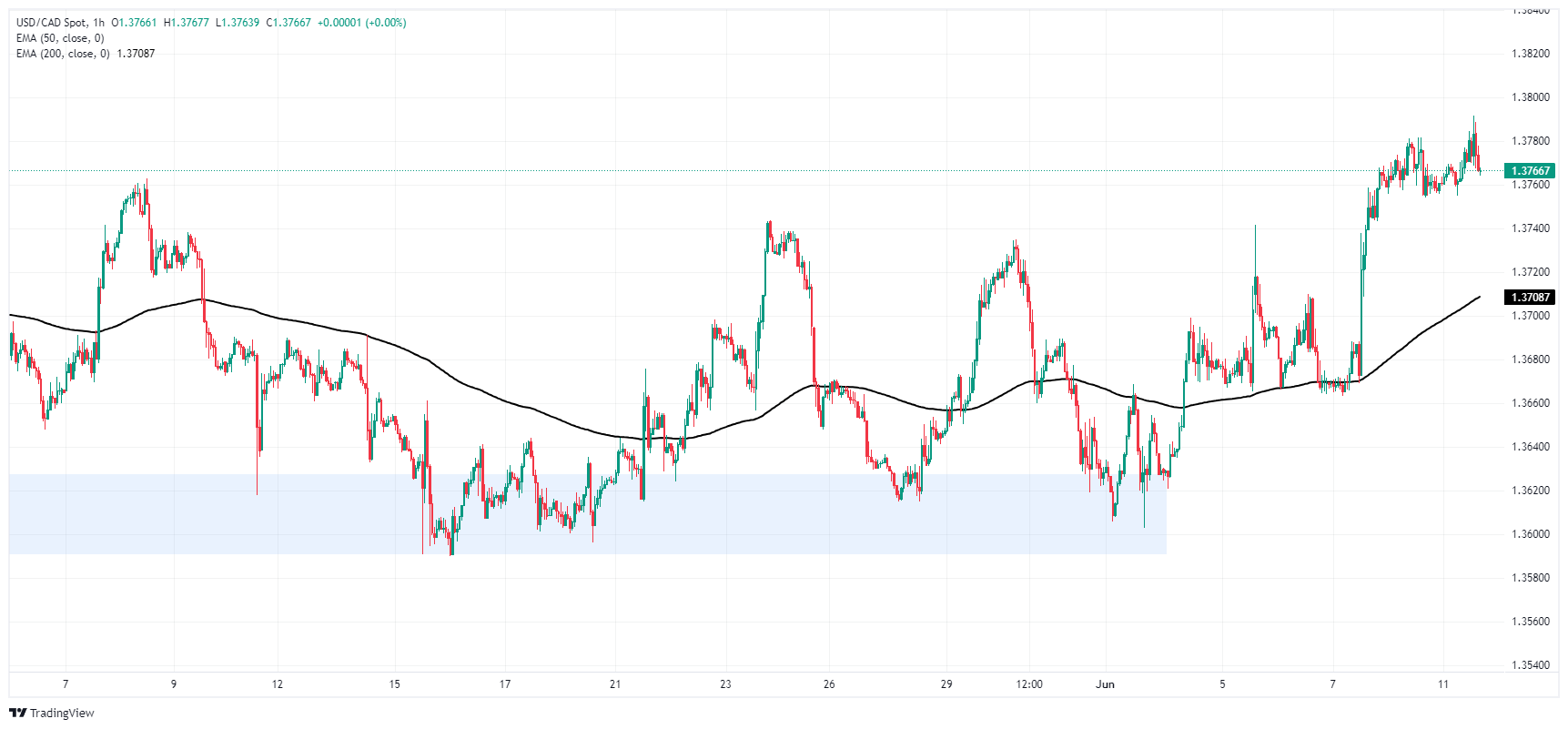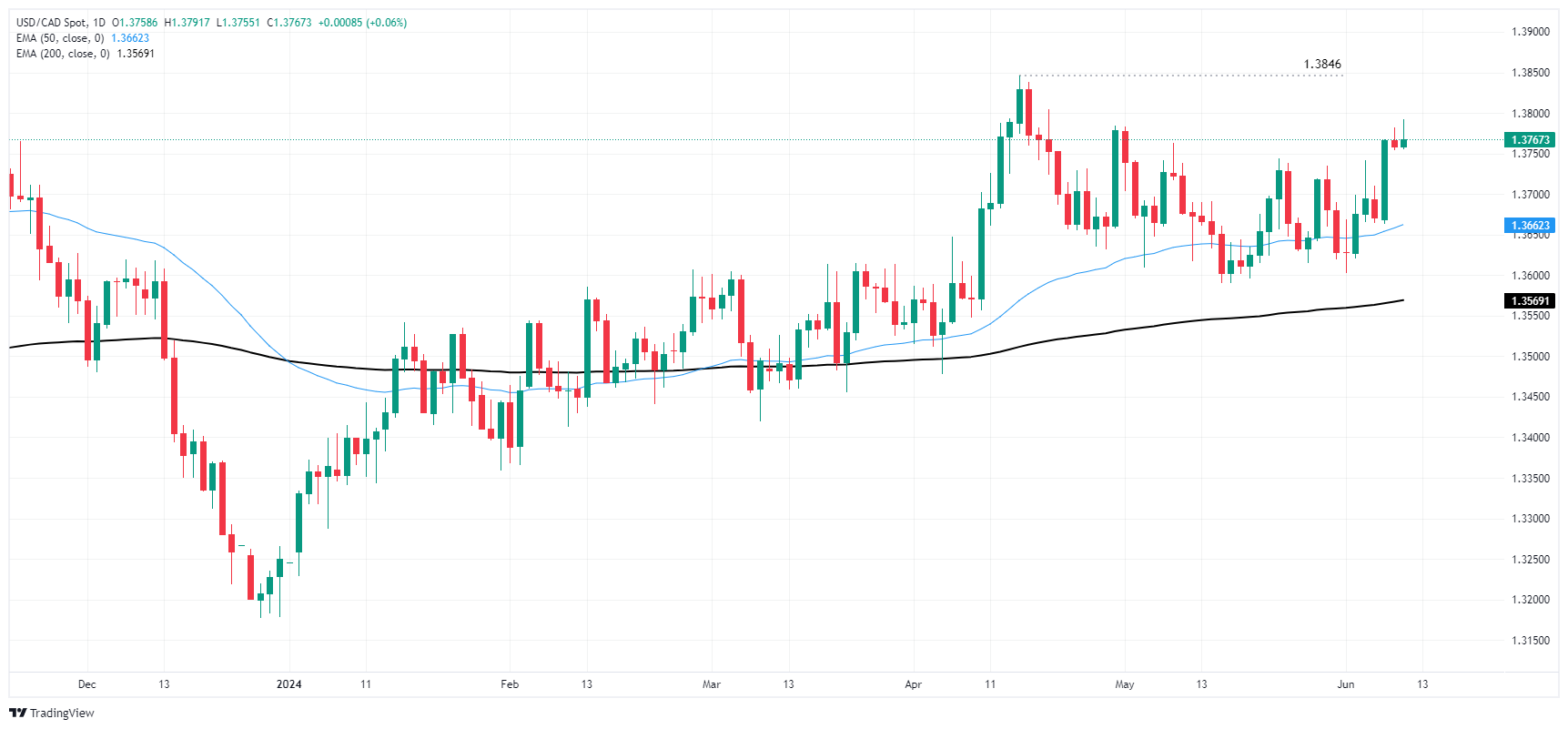- Phân tích
- Tin tức và các công cụ
- Tin tức thị trường
- Canadian Dollar holds flat as markets buckle down ahead of Fed ‘dot plot’ update
Canadian Dollar holds flat as markets buckle down ahead of Fed ‘dot plot’ update
- Canadian Dollar trades steadily on Tuesday with little momentum.
- Canada brings strictly low-tier data to the table this week.
- Fed rate cut expectations still dominate market outlook.
The Canadian Dollar (CAD) is trading mostly flat on Tuesday as investors stubbornly dig in their heels ahead of Wednesday’s key data prints from the US. US Consumer Price Index (CPI) inflation is slated for the midweek market session, followed by a fresh rate call from the Federal Reserve (Fed) that is broadly expected to hold rates in the 500-525 basis point range.
Canada is limited to just low-tier economic data releases this week, except for a single showing from the Bank of Canada’s (BoC) Governor Tiff Macklem, who is slated to make an appearance on Wednesday. However, the BoC Governor’s statement is likely to get drowned out by market reactions to shifts in the Fed’s “dot plot” of Interest Rate Projections due at the same time as the Fed’s rate call this week.
Daily digest market movers: Markets getting nervous ahead of mega Wednesday Fed showing
- CAD finds little reason to move, trades within a quarter of a percent against its peers.
- Canadian Building Permits surged by 20.5% in April, the highest MoM change in four years.
- Markets are hoping that US CPI inflation cools to 0.1% MoM in May, down from the previous 0.3%.
- US Core CPI is forecast to tick down to 3.5% YoY versus the previous 3.6%.
- Fed is broadly expected to keep rates where they are for now, but investors will be keenly focused on Fed’s updated “dot plot” on Wednesday.
- Rate markets see slightly better-than-even odds of at least a quarter-point cut from the Fed in September, according to the CME’s FedWatch Tool.
Canadian Dollar PRICE Today
The table below shows the percentage change of Canadian Dollar (CAD) against listed major currencies today. Canadian Dollar was the strongest against the Euro.
| USD | EUR | GBP | JPY | CAD | AUD | NZD | CHF | |
|---|---|---|---|---|---|---|---|---|
| USD | 0.26% | 0.05% | 0.19% | 0.07% | 0.18% | -0.08% | 0.23% | |
| EUR | -0.26% | -0.21% | -0.07% | -0.19% | -0.07% | -0.34% | -0.02% | |
| GBP | -0.05% | 0.21% | 0.14% | 0.01% | 0.12% | -0.14% | 0.17% | |
| JPY | -0.19% | 0.07% | -0.14% | -0.12% | -0.02% | -0.29% | 0.04% | |
| CAD | -0.07% | 0.19% | -0.01% | 0.12% | 0.11% | -0.16% | 0.16% | |
| AUD | -0.18% | 0.07% | -0.12% | 0.02% | -0.11% | -0.27% | 0.04% | |
| NZD | 0.08% | 0.34% | 0.14% | 0.29% | 0.16% | 0.27% | 0.32% | |
| CHF | -0.23% | 0.02% | -0.17% | -0.04% | -0.16% | -0.04% | -0.32% |
The heat map shows percentage changes of major currencies against each other. The base currency is picked from the left column, while the quote currency is picked from the top row. For example, if you pick the Canadian Dollar from the left column and move along the horizontal line to the US Dollar, the percentage change displayed in the box will represent CAD (base)/USD (quote).
Technical analysis: CAD cycles familiar levels, but some Greenback strength pokes through
The Canadian Dollar (CAD) is trading tightly on Tuesday, refusing to give up too much ground to the Greenback and sticking to familiar intraday technical levels. Elsewhere, the Canadian Dollar is finding small gains, climbing around a fifth of one percent against the Euro (EUR), Swiss Franc (CHF) and Japanese Yen (JPY).
USD/CAD briefly tested above 1.3780 in early Tuesday trading as the US Dollar builds on minor risk-off flows, but the CAD is holding steady, limiting movement in the pair. CAD bidders will be looking for Greenback weakness to drag USD/CAD back down from the 1.3800 handle.
2024’s highs rest at 1.3846, and any downside plunges in USD/CAD will find a demand zone just above the 1.3600 handle. Daily candlesticks are still holding on the high side, trading up nearly 4% for the year.
USD/CAD hourly chart
USD/CAD daily chart
Canadian Dollar FAQs
The key factors driving the Canadian Dollar (CAD) are the level of interest rates set by the Bank of Canada (BoC), the price of Oil, Canada’s largest export, the health of its economy, inflation and the Trade Balance, which is the difference between the value of Canada’s exports versus its imports. Other factors include market sentiment – whether investors are taking on more risky assets (risk-on) or seeking safe-havens (risk-off) – with risk-on being CAD-positive. As its largest trading partner, the health of the US economy is also a key factor influencing the Canadian Dollar.
The Bank of Canada (BoC) has a significant influence on the Canadian Dollar by setting the level of interest rates that banks can lend to one another. This influences the level of interest rates for everyone. The main goal of the BoC is to maintain inflation at 1-3% by adjusting interest rates up or down. Relatively higher interest rates tend to be positive for the CAD. The Bank of Canada can also use quantitative easing and tightening to influence credit conditions, with the former CAD-negative and the latter CAD-positive.
The price of Oil is a key factor impacting the value of the Canadian Dollar. Petroleum is Canada’s biggest export, so Oil price tends to have an immediate impact on the CAD value. Generally, if Oil price rises CAD also goes up, as aggregate demand for the currency increases. The opposite is the case if the price of Oil falls. Higher Oil prices also tend to result in a greater likelihood of a positive Trade Balance, which is also supportive of the CAD.
While inflation had always traditionally been thought of as a negative factor for a currency since it lowers the value of money, the opposite has actually been the case in modern times with the relaxation of cross-border capital controls. Higher inflation tends to lead central banks to put up interest rates which attracts more capital inflows from global investors seeking a lucrative place to keep their money. This increases demand for the local currency, which in Canada’s case is the Canadian Dollar.
Macroeconomic data releases gauge the health of the economy and can have an impact on the Canadian Dollar. Indicators such as GDP, Manufacturing and Services PMIs, employment, and consumer sentiment surveys can all influence the direction of the CAD. A strong economy is good for the Canadian Dollar. Not only does it attract more foreign investment but it may encourage the Bank of Canada to put up interest rates, leading to a stronger currency. If economic data is weak, however, the CAD is likely to fall.
© 2000-2024. Bản quyền Teletrade.
Trang web này được quản lý bởi Teletrade D.J. LLC 2351 LLC 2022 (Euro House, Richmond Hill Road, Kingstown, VC0100, St. Vincent and the Grenadines).
Thông tin trên trang web không phải là cơ sở để đưa ra quyết định đầu tư và chỉ được cung cấp cho mục đích làm quen.
Giao dịch trên thị trường tài chính (đặc biệt là giao dịch sử dụng các công cụ biên) mở ra những cơ hội lớn và tạo điều kiện cho các nhà đầu tư sẵn sàng mạo hiểm để thu lợi nhuận, tuy nhiên nó mang trong mình nguy cơ rủi ro khá cao. Chính vì vậy trước khi tiến hành giao dịch cần phải xem xét mọi mặt vấn đề chấp nhận tiến hành giao dịch cụ thể xét theo quan điểm của nguồn lực tài chính sẵn có và mức độ am hiểu thị trường tài chính.
Sử dụng thông tin: sử dụng toàn bộ hay riêng biệt các dữ liệu trên trang web của công ty TeleTrade như một nguồn cung cấp thông tin nhất định. Việc sử dụng tư liệu từ trang web cần kèm theo liên kết đến trang teletrade.vn. Việc tự động thu thập số liệu cũng như thông tin từ trang web TeleTrade đều không được phép.
Xin vui lòng liên hệ với pr@teletrade.global nếu có câu hỏi.















